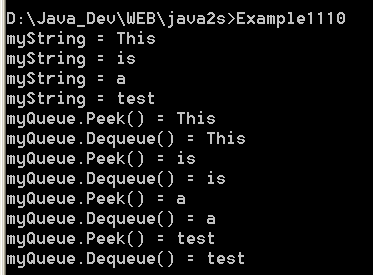illustrates the use of a Queue

/*
Mastering Visual C# .NET
by Jason Price, Mike Gunderloy
Publisher: Sybex;
ISBN: 0782129110
*/
/*
Example11_10.cs illustrates the use of a Queue
*/
using System;
using System.Collections;
public class Example11_10
{
public static void Main()
{
// create a Queue object
Queue myQueue = new Queue();
// add elements to myQueue using the Enqueue() method
myQueue.Enqueue("This");
myQueue.Enqueue("is");
myQueue.Enqueue("a");
myQueue.Enqueue("test");
// display the elements in myQueue
foreach (string myString in myQueue)
{
Console.WriteLine("myString = " + myString);
}
// get the number of elements in myQueue using the
// Count property
int numElements = myQueue.Count;
for (int count = 0; count < numElements; count++)
{
// examine an element in myQueue using Peek()
Console.WriteLine("myQueue.Peek() = " +
myQueue.Peek());
// remove an element from myQueue using Dequeue()
Console.WriteLine("myQueue.Dequeue() = " +
myQueue.Dequeue());
}
}
}
Related examples in the same category